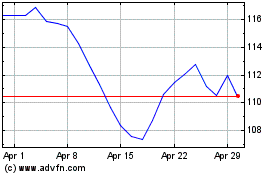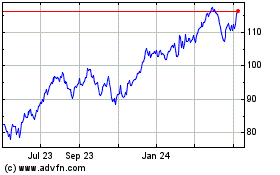Allstate, Chubb Profits Rise on Disaster Claim Decline, Premium Growth -- Update
February 05 2020 - 5:46PM
Dow Jones News
By Leslie Scism
Property-and-casualty insurance giants Chubb Ltd. and Allstate
Corp. posted strong profit gains in the fourth quarter, thanks to
fewer catastrophe claims and premium volume growth.
For U.S. property-casualty insurers, the most-recent quarter
included Texas tornadoes and California wildfires, but the damage
was light compared with the fourth quarter of 2018. Then, Hurricane
Michael landed near Mexico Beach, Fla., and California blazes
caused historic devastation.
Across the insurance industry, investors are looking closely at
movement in prices to gain comfort that years of price competition
may finally be ending.
Prudential Financial Inc., one of the nation's biggest life
insurers by assets, reported a jump in net income, too. But it
posted declines in sales of certain bread-and-butter life-insurance
policies and retirement-income products to individuals in results
reflecting tough conditions across the U.S. life-insurance
industry.
Ultralow interest rates are hurting yields on life insurers'
bondholdings, driving up the prices they charge to consumers and
leading to less-generous benefits.
Chubb's bottom line more than tripled, to $1.17 billion, while
Allstate reversed a year-earlier loss to post $1.71 billion in net
income. Chubb is one of the nation's biggest insurers of businesses
and is a leading seller of property insurance to wealthy people, as
measured by premium. Allstate is a top issuer of car and home
policies.
Shares of all three insurers, which reported their results after
the close of trading Tuesday, were up sharply, led by Chubb with a
7.2% gain. Allstate shares rose 4%.
Chubb's catastrophe losses totaled $353 million, down from $506
million the prior-year period, while Allstate's dropped to $295
million from $963 million. Chubb has a global business, and its
most-recent results also were weighed down by Typhoon Hagibis in
Japan and civil unrest in Hong Kong and Chile.
Chubb's results provided a strong indication for investors of
diminished price competition across business insurers. Chief
Executive Evan Greenberg said in an earnings call Wednesday morning
that premium rates are "improved and improving." He cited
percentage increases ranging from the mid single digits to more
than 20% across different types of coverage.
Chubb's property-casualty "net premiums written," an industry
term for revenue, grew 9% in the quarter to $7.4 billion, lifted by
new sales and rate increases.
In contrast, car insurers like Allstate have won approval from
many state insurance departments for rate increases on a fairly
steady basis since 2015, when a spike in traffic deaths caught the
industry by surprise.
At that time, more drivers were suddenly on the road with
increased mileage amid the economic recovery and distracted driving
was growing as a concern. An overall jump in claims contributed to
widespread profit declines, as did higher costs of repairing new
vehicles due to sophisticated safety equipment
Allstate's overall premiums grew 4.4% to $8.74 billion. The
company said the average premium in auto is up 3%.
"The personal-lines pricing environment has been more consistent
than the ups and downs in the commercial space," Chief Executive
Tom Wilson said in an interview.
Mr. Wilson credited an expense-reduction campaign for part of
the company's profit surge. It has been deploying additional
technology to wring out costs.
Chubb said earnings improved even as its U.S.
agriculture-insurance business posted an underwriting loss due to
crop-yield shortfalls resulting from poor growing conditions. The
company insures more than 100 crops over some 65 million acres.
Prudential posted fourth-quarter net income of $1.13 billion, up
from $842 million, in the year-earlier quarter. But its "adjusted
operating income," which analysts follow closely because it
excludes nonrecurring items, fell 8.2% to $950 million from $1.04
billion.
Prudential's investment-management arm, on the other hand,
reported higher asset-management fees from an increase in average
assets under management, driven by market appreciation and
fixed-income net flows, the company said.
After the market closed Wednesday, life insurer MetLife Inc.
posted a 73% drop in net income to $536 million, as results were
affected by $1.47 billion of mark-to-market losses on derivatives
used for hedging against low interest rates.
The hedges lost value in the fourth quarter as interest rates
rose. The New York company's "adjusted earnings" rose 37% to $1.83
billion. Profit in the insurer's U.S. operations declined 1%, as
earnings rose sharply in its group-benefits unit but fell in its
auto-insurance business because of unfavorable underwriting
results. Its large Asian life-insurance operations posted higher
profit too, driven by volume growth.
Write to Leslie Scism at leslie.scism@wsj.com
(END) Dow Jones Newswires
February 05, 2020 17:31 ET (22:31 GMT)
Copyright (c) 2020 Dow Jones & Company, Inc.
Prudential Financial (NYSE:PRU)
Historical Stock Chart
From Mar 2024 to Apr 2024

Prudential Financial (NYSE:PRU)
Historical Stock Chart
From Apr 2023 to Apr 2024
